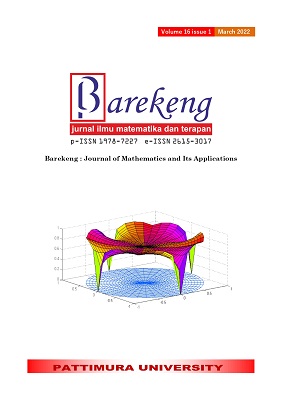D-OPTIMAL DESIGNS FOR SPLIT-PLOT MIXTURE PROCESS VARIABLE DESIGNS OF THE STEEL SLAG EXPERIMENT
Abstract
The nature of the steel slag concrete experiment followed a mixture process variable (MPV) design. In this study, the concrete is composed of five mixture components, cement, fine aggregate, coarse aggregate, percentage steel slag replaced the fine aggregate and water, and process variable was the size of steel slag. Due to the constraints of the components, the experimental region was not a simplex. The standard MPV of a quadratic model produces large experimental runs. In this paper, D-optimal design with split- plot MPV approach was proposed. The five mixture components were assigned as the subplot factors and the process variable was assigned as the whole plot factors. The main objective of this information is a modified point exchange algorithm was developed to generate the D-optimal design. In addition, the paper investigates related issue namely, the estimation of the covariant matrix in MPV split-plot design. The final design consisted of 18 whole plots each of size 2 and experiment design with 36 observations
Downloads
References
J. A. Cornell, Experiments with mixtures: design, models, and data analysis of mixture data, 3rd ed. New York: John Wiley& Sons, 2002.
J. Lawson, Design and Analysis of Experiments with R, Vol. 15. CRC press, 2014.
F. Arina, A. H. Wigena, I. M. Sumertajaya, and U. Syafitri, “Mixture designs for quadratic models with constrained experimental regions on ground granulated blast furnace slag concrete,” Appl. Math. Sci., vol. 12, no. 26, pp. 1251–1258, 2018, doi: 10.12988/ams.2018.89128.
P. C. Schoonees, N. J. Le Roux, and R. L. J. Coetzer, “Flexible graphical assessment of experimental designs in R: The vdg package,” J. Stat. Softw., vol. 74, no. 3, 2016, doi: 10.18637/jss.v074.i03.
F. Arina, A. H. Wigena, I. M. Sumertajaya, and U. Syafitri, “Split Plot Mixture Process Variable Experiment on Steel Slag Concrete,” IOP Conf. Ser. Earth Environ. Sci., vol. 187, no. 1, 2018, doi: 10.1088/1755-1315/187/1/012049.
C. Y. Lin, “Robust split-plot designs for model misspecification,” J. Qual. Technol., vol. 50, no. 1, pp. 76–87, 2018, doi: 10.1080/00224065.2018.1404325.
I. J. David, O. E. Asiribo, and H. G. Dikko, “On Parameters Estimation of Nonlinear Split-Plot Design Model with EGLS-MLE,” vol. 2, no. 1, pp. 381–386, 2018.
S. M. Kowalski, J. A. Cornell, and G. G. Vining, “Split-plot designs and estimation methods for mixture experiments with process variables,” Technometrics, vol. 44, no. 1, pp. 72–79, 2002, doi: 10.1198/004017002753398344.
G. Gakenia Njoroge, “An Optimal Split-Plot Design for Performing a Mixture-Process Experiment,” Sci. J. Appl. Math. Stat., vol. 5, no. 1, p. 15, 2017, doi: 10.11648/j.sjams.20170501.13.
M. A. Sitinjak, U. D. Syafitri, and Erfiani, “A Split Plot Design for an Optimal Mixture Process Variable Design of a Baking Experiment,” J. Phys. Conf. Ser., vol. 1417, no. 1, 2019, doi: 10.1088/1742-6596/1417/1/012018.
W. G. M. Akkermans, H. Coppenolle, and P. Goos, “Optimal design of experiments for excipient compatibility studies,” Chemom. Intell. Lab. Syst., vol. 171, no. September, pp. 125–139, 2017, doi: 10.1016/j.chemolab.2017.09.012.
N. I. Mohamad Zen, S. S. Abd Gani, R. Shamsudin, and H. R. Fard Masoumi, “The use of D-optimal mixture design in optimizing development of okara tablet formulation as a dietary supplement,” Sci. World J., vol. 2015, 2015, doi: 10.1155/2015/684319.
U. A. Wizsa, U. D. Syafitri, and A. H. Wigena, “The Bayesian D-Optimal Design In Mixture Experimental Design,” 2020, doi: 10.4108/eai.2-8-2019.2290470.
Y. Syukri, B. H. Nugroho, and I. Istanti, “Penggunaan D-Optimal Mixture Design untuk Optimasi dan Formulasi Self-Nano Emulsifying Drug Delivery System (SNEEDS) Asam Mefenamat,” J. Sains Farm. Klin., vol. 7, no. 3, p. 180, 2020, doi: 10.25077/jsfk.7.3.180-187.2020.
P. Goos and M. Vandebroek, “D-Optimal split-plot designs with given numbers and sizes of whole plots,” Technometrics, vol. 45, no. 3, pp. 235–245, 2003, doi: 10.1198/004017003000000050.
P. Das B. K. Sinha, N. K. Mandal, Manisha Pal, Lecture Notes in Statistics 1028 Optimal Mixture Experiments. .
D. F. Webb, J. M. Lucas, and J. J. Borkowski, “Factorial Experiments when Factor Levels Are Not Necessarily Reset,” J. Qual. Technol., vol. 36, no. 1, pp. 1–11, 2004, doi: 10.1080/00224065.2004.11980248.
F. Arina, A. H. Wigena, I. M. Sumertajaya, and U. Syafitri, “Pengembangan Rancangan Optimal Untuk Rancangan Campuran Dengan Peubah Proses Pada Petak Terbagi Menggunakan Pendekatan Kriteria D-Optimal,” Institus Pertanian Bogor, 2019.
A. V. Gelman, A, J. B. Carlin, H. S. Stern, D. B. Dunson, Bayesian data analysis, 3rd ed., vol. 53, no. 9. Chapman and Hall/CRC, 2013.
Authors who publish with this Journal agree to the following terms:
- Author retain copyright and grant the journal right of first publication with the work simultaneously licensed under a creative commons attribution license that allow others to share the work within an acknowledgement of the work’s authorship and initial publication of this journal.
- Authors are able to enter into separate, additional contractual arrangement for the non-exclusive distribution of the journal’s published version of the work (e.g. acknowledgement of its initial publication in this journal).
- Authors are permitted and encouraged to post their work online (e.g. in institutional repositories or on their websites) prior to and during the submission process, as it can lead to productive exchanges, as well as earlier and greater citation of published works.






1.gif)



